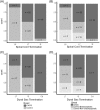Morphometric analysis of spinal cord termination in Cavalier King Charles Spaniels
- PMID: 30758868
- PMCID: PMC6430917
- DOI: 10.1111/jvim.15437
Morphometric analysis of spinal cord termination in Cavalier King Charles Spaniels
Erratum in
-
Erratum for Morphometric analysis of spinal cord termination in Cavalier King Charles Spaniels.J Vet Intern Med. 2019 Jul;33(4):1840. doi: 10.1111/jvim.15514. Epub 2019 May 10. J Vet Intern Med. 2019. PMID: 31321833 Free PMC article. No abstract available.
Abstract
Background: There is an association between Chiari malformations, syringomyelia (CMSM) and tethered cord syndrome (TCS) in people, suggesting Cavalier King Charles Spaniels (CKCS) with CMSM could also have TCS. Currently there are no data on the position of the caudal spinal cord structures in CKCS.
Objective: To describe and compare location of spinal cord termination in CKCS with weight-matched controls and to examine the relationship between SM and spinal cord termination.
Animals: Thirty-nine CKCS and 33 controls with thoracolumbar MRIs; 34 of 39 CKCS also had cervical MRIs.
Methods: Blinded retrospective study. Spinal cord and dural sac termination were determined from T2-weighted sagittal and transverse images and half-Fourier acquisition single-shot turbo spin echo sequences. Intra-observer reliability was determined using kappa analysis. Presence of SM was compared with location of spinal cord and dural sac termination.
Results: Intra-observer reliability was moderate for identifying spinal cord termination (Kappa = 0.6) and good for dural sac termination (Kappa = 0.8). The spinal cord terminated at lumbar vertebra 6 (L6) in 1, 7 (L7) in 22, and sacrum in 16 CKCS versus 9 at L6, 23 at L7, 1 at sacrum in controls. Spinal cord (P < .001) and dural sac (P = .002) termination were significantly more caudal in CKCS compared to controls. The presence of thoracolumbar SM was associated with more caudal dural sac termination in CKCS (P = .03).
Conclusions and clinical importance: The relationship between TL SM and possible spinal cord tethering because of a more caudal dural sac termination should be investigated.
Keywords: conus medullaris; dural sac; filum terminale; syringomyelia.
© 2019 The Authors. Journal of Veterinary Internal Medicine published by Wiley Periodicals, Inc. on behalf of the American College of Veterinary Internal Medicine.
Conflict of interest statement
Authors declare no conflict of interest.
Figures




Similar articles
-
Association between filum terminale internum length and pain in Cavalier King Charles spaniels with and without syringomyelia.J Vet Intern Med. 2021 Jan;35(1):363-371. doi: 10.1111/jvim.16023. Epub 2021 Jan 11. J Vet Intern Med. 2021. PMID: 33426675 Free PMC article.
-
Comparison of high-field MRI and multidetector CT for grading Chiari-like malformation and syringomyelia in Cavalier King Charles Spaniels.Vet Radiol Ultrasound. 2020 Jul;61(4):444-452. doi: 10.1111/vru.12862. Epub 2020 Apr 24. Vet Radiol Ultrasound. 2020. PMID: 32329949
-
Distribution of syringomyelia along the entire spinal cord in clinically affected Cavalier King Charles Spaniels.Vet J. 2011 Dec;190(3):359-63. doi: 10.1016/j.tvjl.2010.12.002. Epub 2011 Jan 8. Vet J. 2011. PMID: 21216639
-
An update on the pathogenesis of syringomyelia secondary to Chiari-like malformations in dogs.Vet J. 2013 Dec;198(3):551-9. doi: 10.1016/j.tvjl.2013.07.014. Epub 2013 Aug 12. Vet J. 2013. PMID: 23938004 Review.
-
Inheritance of occipital bone hypoplasia (Chiari type I malformation) in Cavalier King Charles Spaniels.J Vet Intern Med. 2004 Sep-Oct;18(5):673-8. doi: 10.1892/0891-6640(2004)18<673:ioobhc>2.0.co;2. J Vet Intern Med. 2004. PMID: 15515584 Review.
Cited by
-
Holocord syringomyelia in 18 dogs.Front Vet Sci. 2025 Jan 8;11:1514441. doi: 10.3389/fvets.2024.1514441. eCollection 2024. Front Vet Sci. 2025. PMID: 39846019 Free PMC article.
-
Onset of Action of Bupivacaine Administered via Dural Puncture Epidural versus Spinal, Lumbosacral, and Sacrococcygeal Epidural Injections in Dogs: Randomised Clinical Trial.Animals (Basel). 2021 Oct 19;11(10):2996. doi: 10.3390/ani11102996. Animals (Basel). 2021. PMID: 34680015 Free PMC article.
-
Relationship between clinical parameters and malformations in dogs diagnosed with atlanto-axial instability.PLoS One. 2024 Feb 7;19(2):e0293363. doi: 10.1371/journal.pone.0293363. eCollection 2024. PLoS One. 2024. PMID: 38324604 Free PMC article.
-
Dural sac localization using myelography and its application to the lumbosacral epidural in dogs.Open Vet J. 2021 Jan;10(4):371-376. doi: 10.4314/ovj.v10i4.3. Epub 2020 Oct 23. Open Vet J. 2021. PMID: 33614431 Free PMC article.
-
Association between filum terminale internum length and pain in Cavalier King Charles spaniels with and without syringomyelia.J Vet Intern Med. 2021 Jan;35(1):363-371. doi: 10.1111/jvim.16023. Epub 2021 Jan 11. J Vet Intern Med. 2021. PMID: 33426675 Free PMC article.
References
-
- Hechler AC, Moore SA. Understanding and treating Chiari‐like malformation and syringomyelia in dogs. Top Companion Anim Med. 2018;33:1‐11. - PubMed
-
- Parker JE, Knowler SP, Rusbridge C, Noorman E, Jeffery ND. Prevalence of asymptomatic syringomyelia in Cavalier King Charles Spaniels. Vet Rec. 2011;168:667‐667. - PubMed
-
- Cerda‐Gonzalez S, Olby NJ, Broadstone R, McCullough S, Osborne JA. Characteristics of cerebrospinal fluid flow in Cavalier King Charles Spaniels analyzed using phase velocity cine magnetic resonance imaging. Vet Radiol Ultrasound. 2009;50:467‐476. - PubMed
-
- Driver CJ, Volk HA, Rusbridge C, Van Ham LM. An Update on the pathogenesis of syringomyelia secondary to Chiari‐like malformations in dogs. Vet J. 2013;198:551‐559. - PubMed
-
- Fenn J, Schmidt MJ, Simpson H, Driver CJ, Volk HA. Venous sinus volume in the caudal cranial fossa in Cavalier King Charles Spaniels with syringomyelia. Vet J. 2013;197:896‐897. - PubMed
MeSH terms
Grants and funding
LinkOut - more resources
Full Text Sources
Medical

